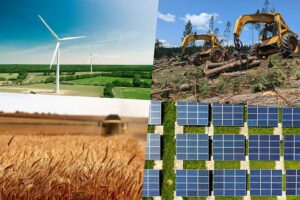EU energy transition “difficult and costly” without biomass investment

If biomass were excluded from the European energy system, it would cost an extra €169 billion per year – about the same as the cost of excluding wind power.
With growing demand for non-fossil alternatives, the competition for renewable resources has intensified – prompting policymakers and industry to address questions about policies and investments into resources and technologies that effectively support the energy sector's climate transition.
As biomass has so many uses, scientists are grappling with questions about the role of bioenergy in the energy system.
A paper published in Nature Energy, details analysis conducted by researchers at Chalmers University of Technology, Rise Research Institutes of Sweden and Technische Universität Berlin.
The researchers investigated two emissions targets for the energy system; one with zero emissions of carbon dioxide and one with negative emissions (minus 110 per cent compared to 1990).
The biomass in the system consists mainly of waste material from forestry and agriculture within Europe, plus a more expensive part which can be imported.
The study's lead author Markus Millinger, a researcher at Chalmers when the study was conducted and now a researcher at Rise, notes that biomass plays an unexpectedly important role in the energy transition.
“One thing that surprised us was how quickly it becomes very expensive if we reduce the availability of biomass in the energy system, due to the high costs of alternatives. If biomass is completely excluded, the costs of the energy system with negative emissions would increase by €169 billion annually, compared to the same system with a cost-optimal level of biomass. This is an increase of 20 per cent, which roughly corresponds to the cost of excluding wind power.”
If biomass availability is limited to the current level of biomass use in the European energy system, the additional cost is 5 per cent compared to the cost-optimal level.
“But the financial part is perhaps not the largest problem”, says Markus Millinger. “The big difficulty may be to scale up the alternatives. Even with biomass in the system, it is a real challenge to expand fossil-free energy to the extent needed. Further restrictions on the supply of biomass would make the energy transition very difficult, as even larger amounts of other types of fossil-free energy would be needed.
“In addition, we would miss out on the opportunity for negative emissions that the utilisation of biomass provides. To then achieve negative emissions in the energy sector, carbon capture directly from the air would instead have to be scaled up to a large extent. This is a significantly more expensive technology that requires an energy input instead of providing a net energy output.”
A key conclusion of the study is that the value of biomass in the energy system is primarily linked to the fact that it contains carbon atoms.
Biomass as an energy source is less important.
The large-scale technologies we have today to utilise the energy content of biomass, for example by burning it in power plants, can be combined with technologies to capture the carbon dioxide in the waste gases.
Then the carbon dioxide can either be stored permanently underground or reused as a building block in products such as fuels and chemicals.
Biomass can thus supply energy and simultaneously enable negative emissions or replace fossil raw materials.
And it is the latter opportunities that have now proven to be most important for the climate transition, added the university.
Consequently, it is crucial that the carbon atoms are captured to be stored or reused efficiently, but it matters less how the energy content of biomass is used.
“As long as the carbon atoms are utilised, it is not crucial in which sector biomass is used, except that it is an advantage to use a small share of the biomass as a flexible reserve for electricity production to strengthen supply reliability,” said Markus Millinger.
“Factors such as regional conditions and existing technical infrastructure are therefore important to determine what is most favourable. This means that countries can choose different paths if they want to use biomass to achieve negative emissions – for example via the production of electrical power, heat or biofuels.”
















